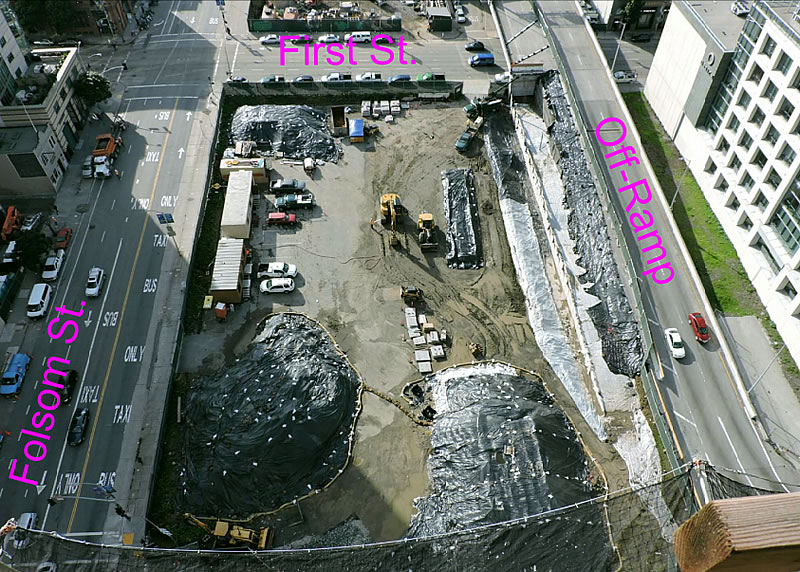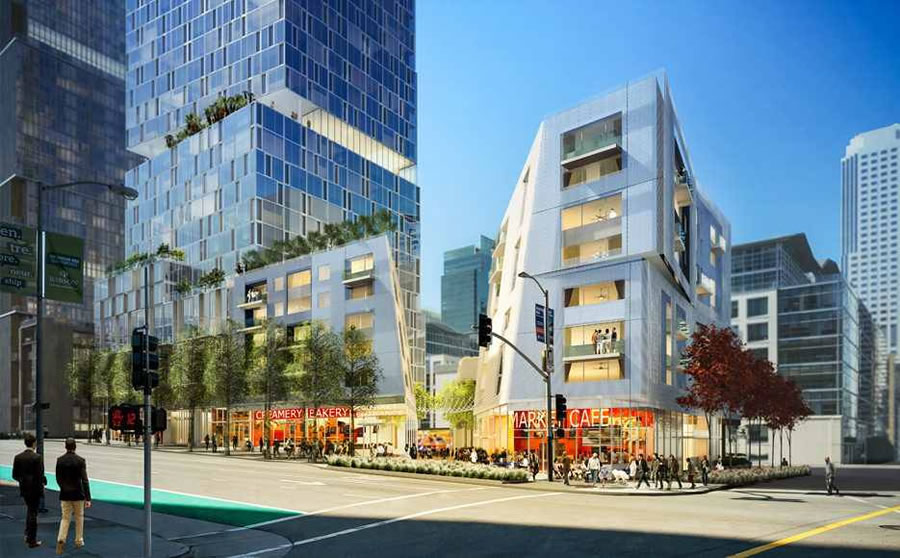Originally expected to be finished this month, the realignment of the Folsom Street off-ramp is now expected to run into June and the budget for the project has been increased 21 percent, from $2,883,900 to $3,479,541.
The delay and cost overruns are primarily due to the discovery of higher than expected levels of motor oil and lead in the soil below, soil which has been stockpiled and covered on site, as pictured above, for testing and proper disposition. And the piles are preventing work on the off-ramp from proceeding as planned.
The Folsom Street off-ramp realignment will clear the way for the 550-foot tower designed by Architect Rem Koolhaas and the Office for Metropolitan Architecture (OMA) to rise on the Transbay Block 8 site, with the potential for a Whole Foods on the corner.
Discussions with Caltrans regarding the ultimate responsibility for the contaminated materials and the cost for its disposition are “ongoing,” according to a memo from the Executive Director of the city’s Office of Community Investment and Infrastructure.


… soil that will be covered over and paved over and never see the light of day (nor affect anyone in the eventual buildings). environmental protection’s one thing, but when we wonder why we can’t have nice things, things such as this are Exhibit A.
They may also be concerned about the soil leeching into groundwater.
because of tranport to the goundwater, a California resorce protected by the State.
name a downgradient user between First and Folsom and the Bay.
You’d need a time machine to see into the future, to assume your question to be relevant to why lead should be removed from a high density environment. Problem is that lead contamination would otherwise last a very, very long time. I’m glad they’re removing it from the midst of where I and my grandkids traffic.
Isn’t the issue that this is soil that needs to go somewhere else? If it’s just going to stay you actually can cap and cover as they did in Emeryville. Or Am I missing something?
I think NJ is right — they have to move that soil at a minimum to dig for a foundation for the Koolhaas building.
When they build a skyscraper they dig a deep hole first and remove the soil. It cant just be covered, it has to go somewhere. They may just not have a plan for where contaminated soil was supposed to go, even if the regular soil they could dump anywhere. It takes them a while to sort out the legal and scientific details. Just a slowdown.
What are they going to do, ship The soil to Mars? The contaminated soil will be displaced somewhere else to contaminate.
No displacement of the contaminated soil! The contaminated soil has a right to stay in SF. Make sure to find a nice new home for the contaminated soil within SF proper.
That darned gentrification and techies kicking out our contaminated soil! Someone should call Mar and Campos, they’ll surely make some legislation requiring high Soil Eviction Buy Out amounts.
All this new uncontaminated soil moving in here and kicking out all the native polluted soil! This is KILLING our city.
Don’t worry, the “contaminated soil advocates” in this city are well connected. They have at least 3 Supervisors in their pocket, probably more.
Technologies exist to treat contaminated soils and groundwater. Brownfield sites can be rendered development-ready while doing the right thing by environmental and public health. In many instances, treatment can happen on site.
Certainly removing it from one of the country’s densest populated areas, to a lesser one, is not a bad idea.
to a special landfill where its impact to the environment is closely monitored and controlled.
So Cal or Utah, depending
I suggest a one-way ticket to Reno.
Maybe Elon Musk can use it for his Gigafactory and convert it into gold.
“Discussions with Caltrans regarding the ultimate responsibility for the contaminated materials…”
No doubt the taxpayer will eventually foot the bill for resolving yet another external cost of the motoring lifestyle. If they can’t pinpoint the polluting party the next fairest thing would be to increase the gas tax to cover the cost of fixing this and countless other sites contaminated with lead and motor oil.
nah. Can’t oppress the motoring public.
The whole point of modern consumer capitalism is to make utterly hidden and distant the true costs of our lifestyles. For the lucky populations, that is.
Heck, i would argue that the gas tax should fund half our insane defense budgets!
A couple million here and there really isn’t that much. I did a quick search and found that between 2002 and 2008, tax payers, via Muni, paid out $66 million just in accident claims. What lifestyle would you have us choose that has no impact and yet is actually functional and usable? I love my e-bike but the batteries are not particularly good for the soil somewhere. And my carbon fiber bike? The epoxies aren’t good for someone, somewhere. Being alive isn’t good for the environment.
It may only be a couple of million, but that’s just for an area of one city block.
I got a titanium bike and will recycle the metal when I need new hips or knees.
I intend to use my bike battery in my pacemaker – it’s a bit big, but I’m strong from all my cycling. But my point is that lots of people have strong opinions about systems they know nothing about.
The source of LEAD south of Market is most likely related to “earthquake fill”. See the Maher Ordinance. This project is within its original limits and is in a known area of elevated metals and hydrocarbons.
Eh, that seems like quite a stretch. The source of lead on the sides of roads is decades of leaded gasoline. Lead is not combustible. Every gram of lead that was ever added to motor fuels is currently sitting on the topsoil on the sides of roads.
And this is something to remember every time we get people fantasizing about urban gardens adjacent to freeways or heavily travelled roads.
No. More likely lead paint on earthquake debris that was used to fill many areas of SOMA. Too much direct evidencethat it is not related to fuel. i.e. elevated lead levels at 10-15 feet below grade on minor alley type streets.
High levels on Rictch Street but none along Geary in the Richmond along 25th
In 1899 the entire block was occupied by foundries: Union Iron Works; Selby, Smelting & Lead; Golden State Miners & Iron Works; and many other businesses in heavy industry. All of which could have contributed.
Another possible cause could have been the former Selby Shot Tower at Howard and 2nd. Long gone (I believe damaged in 1906), but was producing lead pellets. There were likely more buildings in the surrounding blocks dealing with heavy metals.
Correction, it was at Howard and 1st. The very exact block that this contamination was found.
The entire block was occupied by foundries (Union Iron Works), Selby, Smelting & Lead, Golden State Miners & Iron Works, and many other businesses in heavy industry. All of which could have contributed.
There used to be coal gasification plants near here that dumped coal tar waste directly into the Bay. The old Yerba Buena Cove was called the “Tar Flats” because the coal tar was exposed at low tide. Must have been fragrant. Perhaps it still contributes to the sometimes strong stench near the waterfront.
Later they just dumped fill on top to make much of the land. Some places the coal tar is 10 feet thick. There are also some buried fuels storage tanks in this formerly industrial area that were left in the ground and may have contained leaded fuel. A section of the Transbay EIS/EIR (pdf at namelink) has a discussion and includes a map and list of known hazardous material sites nearby.
Paul Stamens has demonstrated on fossil fuel pollutants can be removed from soils by mushroom mycelium. Let the schrooms grow!
It might be easier to just remove or chemically treat the contaminated soil. Mushrooms are finicky beasts and hard to culture.
The area from Folsom to Market and Fremont to the Bay is all one huge dump full of lead and other chemicals. Half of the financial district is all built on early gold rush dump. The most toxic and newest dump is Mission Bay, the area starting from 16th St going north to Brannan st and West to about 7th St. If all the yupsters only knew what there were living on !